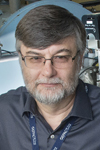Sergey Belomestnykh joins Fermilab this fall as new chief technology officer
 |
|
Sergey Belomestnykh
|
On Oct. 1 scientist Sergey Belomestnykh, currently of Brookhaven National Laboratory, will step in as Fermilab's chief technology officer and Technical Division head.
Although his first day is more than two months away, he is already thinking about how to advance Fermilab's leadership in accelerator technology development.
"Fermilab's Technical Division is a very good division, and it's involved in many exciting programs and projects," Belomestnykh said. "I'd like to maintain the momentum, make sure that projects are conducted efficiently and see that R&D stays very active."
As head of Brookhaven's SRF (superconducting radio-frequency) Group, Belomestnykh helped develop cavities at Brookhaven's Relativistic Heavy Ion Collider and for a possible future electron-ion collider. The IEEE Nuclear Plasma Sciences Society recognized his achievements in the science and technology of RF and SRF for particle accelerators earlier this year with a Particle Accelerator Science and Technology Award. That experience translates well to Fermilab's R&D program, which aims to advance SRF both for fundamental physics and wider applications.
SRF R&D isn't the only thing on Belomestnykh's plate. The Technical Division is developing superconducting solenoids for Mu2e and high-field magnets for the LHC as part of a longstanding collaboration with CERN. In another collaboration with SLAC, the division is contributing SRF cryomodules to LCLS-II. In addition, the division plays an important role in supporting facilities at the Accelerator Division.
Perhaps the Technical Division's most ambitious project will be to help build the PIP-II accelerator, a critical future addition to the laboratory's accelerator complex.
"PIP-II is the next big project for us," he said. "We expect that the division's participation in LCLS-II and other projects will provide us with the experience and skills necessary for the successful realization of PIP-II."
As a scientist who enjoys teaching and mentoring younger talent, Belomestnykh hopes to attract the next generation of scientists at Fermilab by bringing more Ph.D. students to the Technical Division.
"It's important to have good ties with the universities — that's where the young scientists and engineers are coming from," he said.
An IEEE senior member, Belomestnykh served in a number of roles at Cornell University — from visiting scientist to senior research associate — from 1994 to 2011. He arrived at Brookhaven Lab as a physicist and head of the SRF Group in the Collider-Accelerator Department in 2010. He began teaching physics courses at Stony Brook University as adjunct professor in 2011 and was named Brookhaven Professor in 2015.
"Sergey's joining the lab at an exciting time, and we're excited to have him here," said Director Nigel Lockyer. "He understands SRF technology and its use in accelerators as few others do, and we're confident he'll keep Fermilab at the cutting edge of accelerator technology R&D and help deliver our major projects on time and on budget."
—Leah Hesla
|